The 800s decade ran from January 1, 800, to December 31, 809.
The 810s decade ran from January 1, 810, to December 31, 819.

Year 814 (DCCCXIV) was a common year starting on Sunday of the Julian calendar.
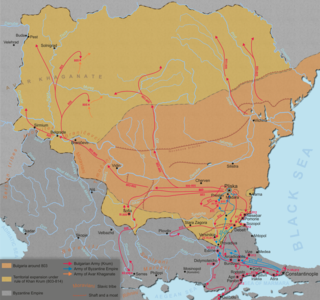
Year 803 (DCCCIII) was a common year starting on Sunday of the Julian calendar.

The Croats or Croatian people are a South Slavic ethnic group native to the Balkans, who share a common Croatian ancestry, culture, history and language. They are also a recognized minority in a number of neighboring countries, namely Austria, the Czech Republic, Germany, Hungary, Italy, Montenegro, Romania, Serbia, Slovakia and Slovenia.

Nikephoros I or Nicephorus I was Byzantine emperor from 802 to 811. Having served Empress Irene as genikos logothetēs, he subsequently ousted her from power and took the throne himself. In reference to his career before becoming emperor, he is sometimes surnamed "the Logothete" and "Genikos" or "Genicus". Nikephoros pursued wars against the Arabs and Bulgarians, with mixed results; while invading Bulgaria he was defeated and killed at the Battle of Pliska.

Michael I Rhangabe was Byzantine emperor from 811 to 813.
Translatio imperii is a historiographical concept that originated from the Middle Ages, in which history is viewed as a linear succession of transfers of an imperium that invests supreme power in a singular ruler, an "emperor". The concept is closely linked to translatio studii. Both terms are thought to have their origins in the second chapter of the Book of Daniel in the Hebrew Bible.
The History of Dalmatia concerns the history of the area that covers eastern coast of the Adriatic Sea and its inland regions, from the 2nd century BC up to the present day.
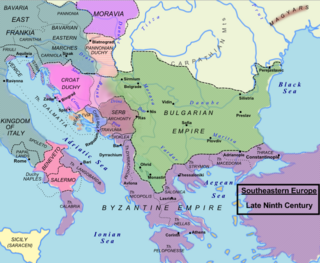
Domagoj was Duke of Croatia from 864 to 876, and the founder of the Domagojević dynasty. He usurped the Croatian throne after the death of Trpimir I and expelled his sons. He took a more active role in the Adriatic Sea than his predecessors, encouraged the use of force and waged many wars, specifically with the Arabs, Venice and the East Francia. Domagoj's belligerence and the tolerance and support of piracy caused bad relations with Pope John VIII, which was further worsened after Domagoj showed no mercy to his conspirators. Formally a Frankish vassal, he used to his advantage the Frankish succession crisis and started a successful revolt against Carloman of Bavaria. After his death in 876, Domagoj was succeeded by his son who was deposed and expelled by Zdeslav in 878.
Vojnomir, Voynomir or Vonomir I was a Slavic military commander in Frankish service, the duke of Slavs in Lower Pannonia, who ruled from c. 790 to c. 800 or from 791 to c. 810 over an area that corresponds to modern-day Slavonia, Croatia.
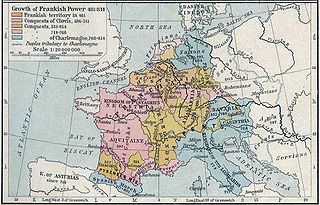
The siege of Trsat was a battle fought over possession of the town of Trsat in Liburnia, near the Croatian–Frankish border. The battle was fought in the autumn of 799 between the defending forces of Dalmatian Croatia under the leadership of Croatian duke Višeslav, and the invading Frankish army of the Carolingian Empire led by Eric of Friuli. The battle was a Croatian victory, and the Frankish commander Eric was killed during the siege.
This article presents a detailed timeline of the history of the Republic of Venice from its legendary foundation to its collapse under the efforts of Napoleon.
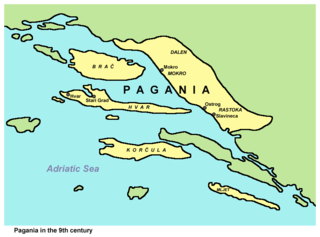
The Narentines were a South Slavic tribe that occupied an area of southern Dalmatia centered at the river Neretva, active in the 9th and 10th centuries, noted as pirates on the Adriatic. Named Narentani in Venetian sources, Greek sources call them Paganoi, "pagans", as they were for long pagan, in a time when neighbouring tribes were Christianized. The tribe were fierce enemies of the Republic of Venice, having attacked Venetian merchants and clergy passing on the Adriatic, and even raided close to Venice itself, as well as defeated the doge several times. Venetian–Narentine peace treaties did not last long, as the Narentines quickly returned to piracy. They were finally defeated in a Venetian crackdown at the turn of the 10th century and disappeared from sources by the 11th century.

The Theme of Dalmatia was a Byzantine theme on the eastern coast of the Adriatic Sea in Southeastern Europe, headquartered at Jadera.

The Duchy of Croatia was a medieval state that was established in the former Roman province of Dalmatia. Throughout its time it had several seats – namely, Klis, Solin, Knin, Bijaći and Nin. It comprised the littoral – the coastal part of today's Croatia – except Istria, and included a large part of the mountainous hinterland as well. The duchy was in the center of competition between the Carolingian Empire and the Byzantine Empire for rule over the area. Rivalry with Venice emerged in the first decades of the 9th century and was to continue for the following centuries. Croatia also waged battles with the Bulgarian Empire, with whom the relations improved greatly afterwards, and the Arabs and sought to extend its control over important coastal cities under the rule of Byzantium. Croatia experienced periods of vassalage to the Franks or Byzantines and de facto independence until 879, when Duke Branimir was recognized as an independent ruler by Pope John VIII. The duchy was ruled by the Trpimirović and Domagojević dynasties. Around 925, during the rule of Tomislav, Croatia became a kingdom.

Venetian Dalmatia refers to parts of Dalmatia under the rule of the Republic of Venice, mainly from the 15th to the 18th centuries. Dalmatia was first sold to Venice in 1409 but Venetian Dalmatia was not fully consolidated from 1420. It lasted until 1797, when the Republic of Venice fell to the forces of Napoleon Bonaparte and Habsburg Austria.

Dalmatian city-states were the Dalmatian localities where the local Romance population survived the Barbarian invasions after the fall of the Western Roman Empire in the 400s CE. Eight little cities were created by those autochthonous inhabitants that maintained political links with the Eastern Roman Empire. The original name of the cities was Jadera, Spalatum, Crespa, Arba, Tragurium, Vecla, Ragusium and Cattarum. The language and the laws were initially Latin, but after a few centuries they developed their own neo-Latin language, that lasted until the 19th century. The cities were maritime centres with a huge commerce mainly with the Italian peninsula and with the growing Republic of Venice.
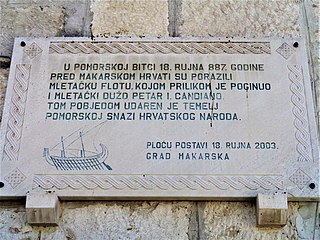
The Croatian–Venetian wars were a series of periodical, punctuated medieval conflicts and naval campaigns waged for control of the northeastern coast of the Adriatic Sea between the City-state of Venice and the Principality of Croatia, at times allied with neighbouring territories – the Principality of the Narentines and Zahumlje in the south and Istrian peninsula in the north. First struggles occurred at the very beginning of the existence of two conflict parties, they intensified in the 9th century, lessened during the 10th century, but intensified again since the beginning of the 11th century.











